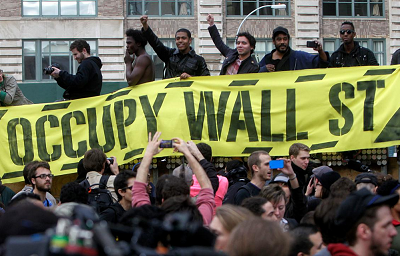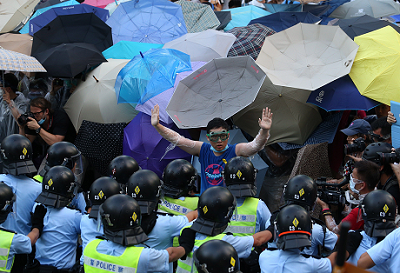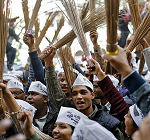The Aam Admi Party’s stunning victory in the Delhi election must be seen in the context of the last five years of mounting street protests across the world which have sought either to dislodge dictators or challenged the failings of existing democracies.
On the surface, this global unrest seems to be driven by demands for better governance in terms of safer streets and less corruption—along with reliable access to jobs and essential goods.
However these are merely symptoms of what may be the most critical challenge of the 21st century—a profound reconfiguring of how political and economic power is acquired and managed.
It is in this context that AAP’s rapid rise to power might serve as a light-house of global significance—a beacon that guides others seeking to take democracy to a higher level and warns of treacherous rocks.
AAP’s trajectory has a multi-dimensional global resonance because :
1. It aims to creatively address the dissonance between capitalism and democracy.
2. It emphasises dignity of the individual as much as access to essential goods.
3. It compels power structures, of government and private sector alike, not just to be accountable and responsive but allow for ground-up participation.
There is an emerging consensus among scholars and political analysts across the world that the 20th century advances in building democratic systems have run their course. The geographical spread and intensity of protests partly illustrates what ails the plateau-like status quo of democracy. A study of the Occupy movement, the Arab Spring and the Latin American and Asian protests, demonstrates this.
AAP and Occupy:
In 2011 the Occupy Wall Street movement, beginning at Zuccotti Park in Manhattan, triggered a cascade of similar protest actions in hundreds of cities across the world—including two locations in China. Across these diverse cultures, one slogan acquired a unifying resonance: “We are the 99%.” This signified a mobilisation against the unprecedented concentration of money and political power globally—most notably in old democracies.

Many commentators in the mainstream media dismissed the ‘Occupy’ activists as a confused lot with no actionable demands.
On the contrary. The two largest and most entrenched Occupy sites, in New York and London, threw up a range of concrete demands aimed at making both private sector and governments more accountable to ethical concerns about fairness and equity.
AAP’s ideological perspective, particularly as articulated by its leading ideologue Yogendra Yadav, echoes the unrest manifest in the ‘Occupy’ phenomenon. However, in the build-up to the Delhi election, there has been a concerted effort to show that AAP is determined to fight crony-capitalism but also that its pro-people agenda is not anti-business. This partly explains why many Indian business leaders have welcomed AAP’s victory and Indian stock markets have reversed a week-long downward trend in response to this election result.
Sifting good capitalism from crony capitalism will be fraught with difficulties. But AAP’s innovations in this sphere will be as much under global scrutiny as the newly-formed government in Greece—which has also been brought to office after sustained street protests against oppressive economic policies.
AAP and the Arab Spring:
Protests in the Arab world were triggered in 2010 by a violation of individual dignity—when a Tunisian street vendor whose weighing scales had been wrongly confiscated by police, killed himself. With the exception of Tunisia, demands for the dignity of participation in an effective democracy have so far been belied in the Arab world. Instead, the Islamic State (ISIS) has arisen as a brutally anti-democratic force, and parts of West Asia have been plunged into civil war.

By contrast, the popular unrest that AAP mobilised happened within the framework of India’s 67 years of experience in protest movements of an established democracy with a vibrant civil society. So while India’s example may not be easy for democracy aspirants in the Arab world to follow, the organisational methods adopted by AAP, and the long sequence of civil society formations which were precursors to the rise of this party, may play an inspirational role.
Even more significantly, those who are struggling to direct Arab movements for democracy away from bitter conflicts over ethnic identity, could take a leaf out of AAP’s insistence on building a secular platform. In the final days of the election campaign when Delhi’s Shahi Imam urged Muslims to vote for AAP, the party rejected this support —asking voters to decide on the basis of issues and not religion.
AAP and Turkey, Latin America, Hong Kong et al:
From varied mass protests in Latin America through the last decade, to the uproar in Thailand and Turkey in 2013, Hong Kong and Taiwan in 2014, one thing is common. In one form or another, people are demanding systems that devolve power to the grassroots. Today it is not enough for citizens to be able to speak truth to power; they want an active role in the management of that power.

Therefore how AAP delivers on its two major election promises will be closely watched—the anti-corruption Lok Pal Bill and the Swaraj Bill which aims to enable citizens to participate in the management of power at the municipal level. More importantly, AAP has to ensure that holding 95.7% seats in the Delhi state legislature does not make its members behave like a brute majority—breeding arrogance or encouraging its supporters to violate civil liberties through acts of vigilantism.
AAP’s moment at centre stage is made particularly poignant by it happening in the same year that Western democracies are celebrating the 800th anniversary of the Magna Carta. This agreement between an English King and his barons made all free men, including the sovereign, subject to the rule of law and is deemed to be the foundation on which modern democracies are built.
But the Magna Carta celebrations are clouded by pervasive concerns about declining voter turnout in many Western democracies. From an all-time high of 83.6% in 1950, UK voter turnout was 65.7% in 2010. In the US, voter turnout in the Presidential elections has gone from an all time high of 95.8% in 1964 to 67.9% in 2012. In Germany the all time high of 91.1% in 1972 was down to 71.5% in 2013.
In contrast, India stands out for qualitative and quantitative increase in engagement by its electorate .
Back in 2010, Yogendra Yadav co-hosted an international dialogue on democracy. Speaking both as an academic and an activist, he noted that the space for exploring more effective constructs of democracy is under-occupied and needs to be filled with a plurality of approaches. Whatever tumult and difficulties lie ahead as AAP grapples with day-to-day governance, there is no going back on the fact that it has—for India and the world—expanded the space for exploring the further evolution of democracy.
Rajni Bakshi is Senior Gandhi Peace Fellow, Gateway House.
A version of this feature was also published by Quartz India.
This article was exclusively written for Gateway House: Indian Council on Global Relations. You can read more exclusive content here.
For interview requests with the author, or for permission to republish, please contact outreach@gatewayhouse.in.
© Copyright 2015 Gateway House: Indian Council on Global Relations. All rights reserved. Any unauthorized copying or reproduction is strictly prohibited


